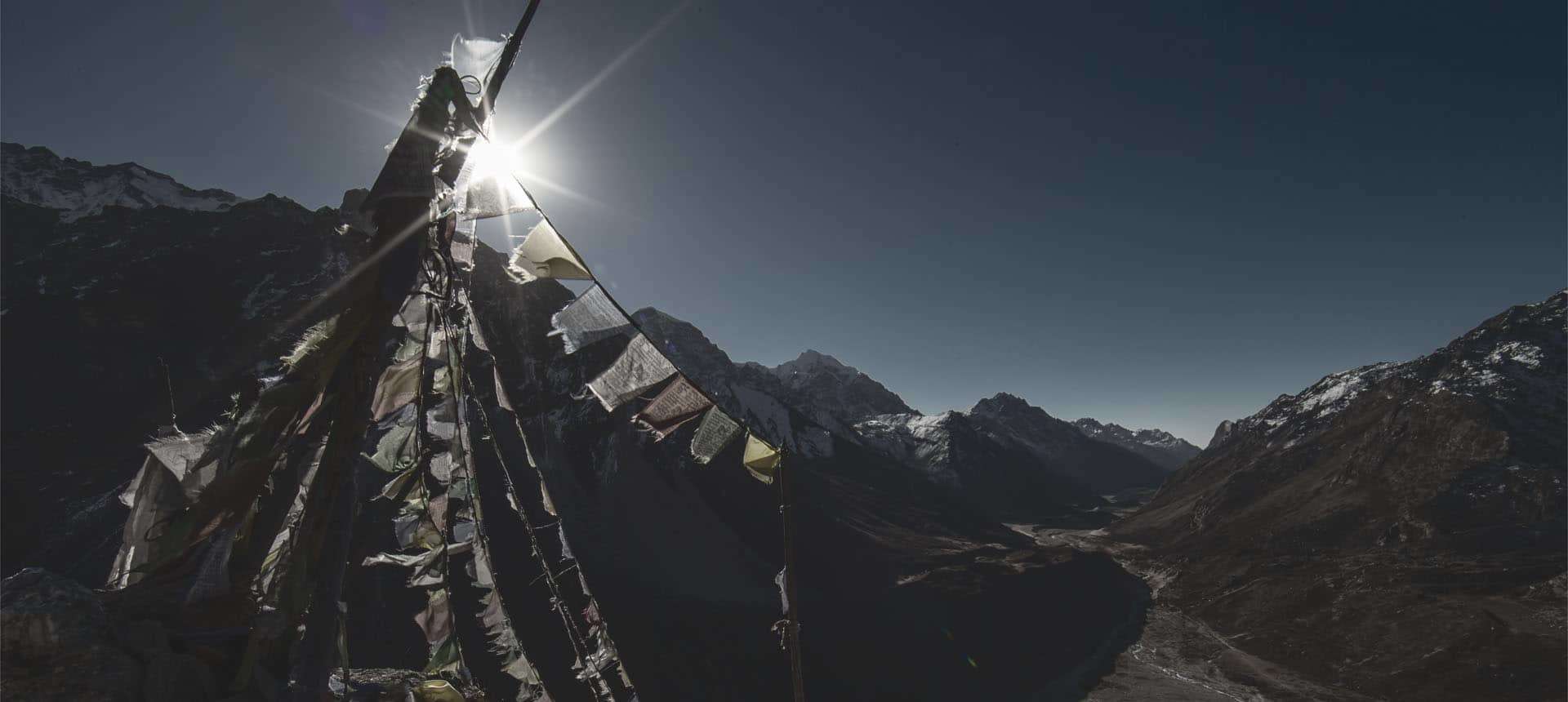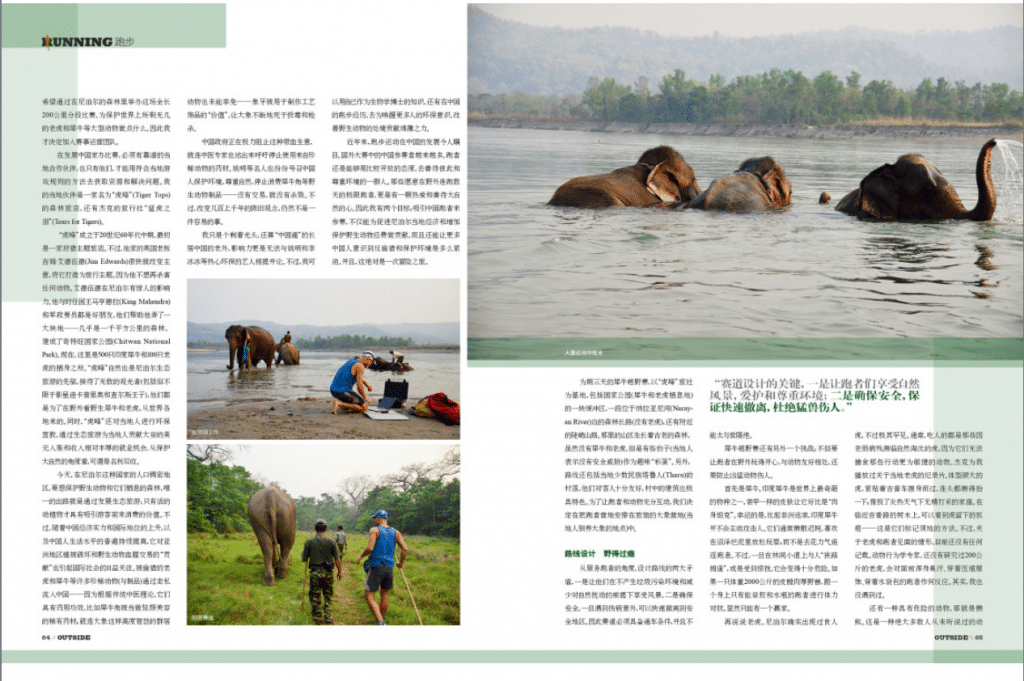
13 Sep The planning stages of the Rhino Run in Outside Magazine
Running with Rhinos
Dr Li Pasha (Pavel Toropov) is a former elite ultra runner ad an old China Hand. He is a PhD in biology, and a frequent contributor to Runner‘s World, Outside, and Action Asia Magazine, and is also a translator for China National Geography Magazine. Dr Li has designed ultra courses and worked on ultra races all around the world.
I am not sure if a race here is even possible, said DB, the operations manager of Tiger Tops. The rhinos can charge if you surprise them, and do you remember that man-eating tiger? Also, the sloth bear – they are very, very aggressive, and mugger crocodiles can be a problem, I think, if you are next to the river or the lake. They ate several fishermen last year.
Jack, my partner, wearing an impeccably clean and pressed shirt, hair neatly combed, was a true Englishman – an old Harrowvian in whose veins ran, in equal measure, aristocratic blood, love of nature and thirst for adventures, did not bat an eyelid. “Let’s think about it – first, that man eating tiger was a one-off, an old female, and that was three years ago. Sloth bear are active at night, no problem there. Rhinos can only be dangerous if you suddenly surprise them and we will patrol all the rhino sections with our elephants, we have fourteen of them, after all. The Nepali army can help us with that too, and they can patrol the lake shore to take care of the crocodiles.”
I had worked on many ultra races, from Madagascar to Bhutan, but this race was promising to be special, unique. It was the first time when I was asked while I was having my morning coffee: “How many elephants do we need today to check the race course, Sir? Would two be enough?”
Rhino Run
In people’s minds Nepal, means high mountains, the Everest, but not many people know that travel to Nepal is a lot more than the views snow-capped peaks, fearless Sherpas and mountain treks. Southern Nepal is covered by jungle, where in the hot, humid lowlands, wild elephants, rhinos and tigers are struggling to survive the onslaught of poaching and deforestation.
I had another reason to want to do this race. Struggling for direction in my life, I was on a search for doing something worthwhile, something that made a difference. I knew how much hard work organising a race was, and I had no desire to take on that responsibility, but this race, in the jungles of Nepal, was different – it was not just arranging an
entertainment program, an adventure tourism package, which is what many of these multi-day ultra races are. This race was about helping to save the world’s last megafauna – tigers and rhinos. And so I committed myself to Rhino Run, a 200km stage race in the jungles of Nepal.
Organising a race in a developing country is impossible without a good, reliable local partner, who will take care of the manpower and deal with the local problems the local way. Our partner was a jungle lodge called Tiger Tops and Jack’s travel agency called Tears for Tigers.
Tiger Tops started as a hunting lodge in the 1960s, but the owner, Jim Edwards an Englishman, quickly had a change of heart and turned it into a safari lodge, he simply did not want to kill anything anymore. He was also incredibly influential in Nepal – the King Mahendra and the military leaders were amongst his friends and it was Jim Edwards that was instrumental in designating the entire area as Chitwan National Park – almost a thousand square kilometres of jungle, now home to around 500 Indian rhino, and more than 100 Bengal tigers.
Nowadays the only way to protect the wildlife and forests in areas of high human density in countries like Nepal is through tourism – animals and trees have a value attracting tourist dollars, becoming worth more alive than dead. Unfortunately, China’s regaining its rightful place as a world superpower, with the rise of the people’s incomes and living standards, has turned it into the financial backer of the destruction of the forests and wildlife in Asia. Tigers are killed for their bodyparts to be used in Chinese medicine, rhinos are butchered for their horns purchased by rich men who are trying to stop the inevitable course of time, and elephants, these highly intelligent, social animals, are poisoned and shot so that their tusks can be carved into trinkets.
The Chinese government is taking active steps in stopping the rhino horn and tiger bodypart trade, and the leading Chinese medicine doctors have pledged not to use such products. Also, Chinese celebrities like Yao Ming are working to increase awareness amongst the Chinese people of the reality of rhino horn trade, but centuries old attitudes are hard to change. I am no Yao Ming (and being a bald foreigner I don’t look anything like Fan Bing Bing, another star lending her fame and looks to the campaign) but, using my biology PhD, and my Chinese running experience, I thought that I could make a small contribution.
The surge of running in China is remarkable. Major overseas races have more and more Chinese runners and the number is growing. Runners tend to be the kind of people who are open to new ideas, and ultra-runners, individuals willing to spend days on end running in the wilderness are the sort of people who would want to protect this wilderness. My aim was two-fold: attracting Chinese runners to Rhino Run would not only inject cash into the local
tourist economy, vital for protecting the park and its rhinos, but will also increase the awareness of the rhino poaching problem amongst the Chinese. And it was promising to be an adventure!
The course of Rhino Run, the three-day stage race, with the lodge as the base, will include the buffer zone of the national park (the rhino and the tiger habitat), the long forested sections (tiger free) by the Narayani River and the steep chain of nearby mountains. Covered by old forests, the mountains are too far from the main park for tigers and rhinos, but with a population of leopards (not a problem, according to the locals) to keep things interesting. We also included the local villages of the Tharu ethnic group, with their unusual traditional architecture and friendly people, into the course. In order ensure the maximum runner – animal interaction, we decided to set up the runners camp inside the elephant camp of the lodge.
Course design – meet the wildlife
Designing a race course you must provide two conflicting services to the runners – great scenery, free of litter, people and traffic, but also security and safety – when things go bad, an injured or dehydrated runner must be evacuated, and so there must be car access to the race course, and hence, roads, and so people and traffic.
Rhino Run, presented an additional challenge. Not only did we want to allow the runners to enjoy the Nepali wilderness and wildlife, but we had to make sure that the same wildlife did try to kill and eat the runners. The problem was further complicated by the fact that there was A LOT of wildlife capable of doing it.
First there were the rhinos. The Indian rhino is one of the most incredible animals there are – an armoured colossus, nature’s tank. Unlike African rhinos, these “tanks” are not aggressive, they move slowly and prefer to spend their time relaxing in the warm mud of a swamp, rather than do any strenuous physical activity like chasing runners, but, surprised by a runner on a narrow jungle trail a rhino could charge. In a clash between a 2000 kg armoured animal and a 70kg ultra runner armed with gels and a water bottle, there could be only one winner.
Then there were the tigers. Man eating tigers are real, but rare. It is usually an old or sick individual, which can no longer hunter fast prey, that makes the switch to hunting humans. I saw videos of tigers filmed nearby, shown me by Jack – an enormous animal walking right next to their jeep without even bothering to look at it, just like a lazy domestic cat might walk past you on hot day. However, part of the future race course, right on the jeep track, had a tree covered in tiger claw scratch marks, a border post of a tiger’s territory. There is no data on the potential response of tigers to ultra – runners, behavioural biologists have never studied how a 200kg cat might react to a sweating, stinking human wearing compression shorts and a backpack, and I did not want to make that experiment myself.
Another dangerous animal, and also endangered one, is a sloth bear. Sloth bears are one of those animals nobody has ever heard of, they look like as if a cartoonist tried to draw half-black bear and half golden retriever. In addition to their bizarre appearance, but they have an uncommon evolutionary response to threat. When confronted by a large animal, such a leopard, tiger (and human) their instinct is not to run off, but to hold their ground and fight. Luckily, these fighting half-dog half-bears are nocturnal.
A sloth bear might fancy his chances against a tiger (or an ultra –runner), but no animal in Nepal would ever challenge the elephant. Tiger Tops lodge had fourteen working elephants, and formerly these were used for safaris – tourists ride an elephant through the jungle to observe the tigers and the rhinos from complete safety.
Elephants
Recently, however, biologists have been speaking out against such use of domestic elephants. An elephant is a very intelligent, social animal with great memory and strong social structure. Current practices of treating domestic elephants in India and Thailand are often extremely cruel. In addition to physical cruelty, for example keeping an elephant on a short chain, and punishing it by beating, psychological abuse is equally terrible – elephants are kept in isolation and subjected to constant stress from people and vehicles surrounding them. Tiger Tops lodge have taken the initiative to treat their elephants humanly, in large enclosures, and stopped elephant safaris and chaining their elephants. On a safari, tourists no longer ride the elephants, but walk alongside them through the forest, to see tigers and rhinos up close. The elephants, however, are the people’s bodyguards, and in case of a tiger approaching a bit too close, the elephants would immediately and instinctively shield people from the danger, trumpeting and beating their trunks on the ground. Such display sends any tiger or leopard back into the forest, tail between its legs.
Elephants were the key part of our plan. In fact, only certain parts of one section of the three-day Rhino Run had a risk of wildlife, and so a joint elephant – military safety measures plan was drawn up. The entire section of rhino forest was to be patrolled with elephants before and while the runners were present there. The idea was to saturate the area with elephant smells and sounds to drive any rhinos or tigers away. Every checkpoint and water station was to have a transportation – bodyguard elephant or two. Sweeping (following the slowest competitors) was to be done with an elephant. The presence of fourteen elephants, I was assured by our local partners, would empty the area of any dangerous wildlife.
The Nepali Army were also willing to help, their units patrol the national park and they were willing to lend us a hand, joining our elephants on rhino-tiger-crocodile patrols. The local people, who make their living from the tourism in the park, have also pledged their contribution as scouts and rhino-guards. The locals were excited about Rhino Run: Nepal
has several running races, but all up in the Himalaya, it was time the jungle part of Nepal got some of that attention too!
The Tiger Tops lodge is situated next to the Narayani river and one of the most beautiful sights that I have ever seen was watching our elephants bathe on its sandy beaches. We had finished checking a section of the race course right by the river bank, the day’s work was done, and the mahouts, the elephant drivers, let their animals enjoy their free evening. It is hard to imagine what a happy elephant looks like, but that evening, the elephants were happy and it had hypnotic effect on us, people, not just the foreigners but also the mahouts who spent their whole lives alongside elephants. We just sat and watched the spectacle that unfolded, smiling to each other.
Our elephants swam, went underwater, sprayed themselves with water, rolled on the sand on their backs, while gently touching each other with their trunks. They were also continuously talking to each other by trumpeting, and by making deep rumbling sounds coming deep from within their vast bodies. Some were playing games underwater, diving to retrieve something from the river bottom. Sometimes only their backsides were visible, like small brown islands, but then a trunk would come out like a periscope of a submarine, spraying water, and finally a head of an elephant would emerge, only to disappear again a second later.
I understood something that evening – I had read about people suffering from severe depression, stress, or post- traumatic stress disorder, showing remarkable improvement after spending time with large, intelligent, animals, such as dolphins and whales. I never understood why it was possible, but, watching elephants play in the river that evening, so close that I could touch them, I understood why. I can’t describe it, you have to be there yourself, to experience elephant happiness and let it work its magic on you.
Pavel Toropov







No Comments